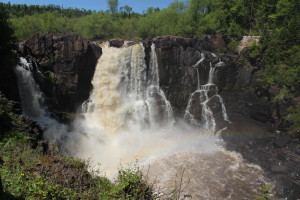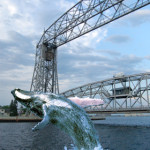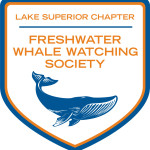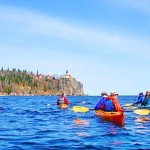Each national park site that Tom and I have worked at has its own distinctive emphasis and personality. This means that each national park site also has its own brand of visitors and visitor questions. I have discussed some of the unique questions that we get at each place in previous posts (Death Valley, Chickamauga, Kings Mountain). I only have a few blog posts left about Grand Portage and Minnesota, so I thought today would be a good time to write about some of the questions asked at Grand Portage.
- One of the questions we don’t get asked at Grand Portage – a stand-out at every other park – is “where are the restrooms?” The reason why we don’t get asked that question is that the restrooms are right behind the Visitor Information desk. If people are looking at us, they can see the signs for the restrooms. We still sometimes get the question, but it is infrequent.
2. Probably the #1 question asked when we are working as living history interpreters is “is that chicken / fish / fire / bread / fur real?” The answer is always “Yes!” because we don’t cook fake stuff or have fake stuff on display. We invite people to touch and smell, to watch how to start a fire 1790’s style, to stick their hand in the bake oven, to see the dirty dishes that come from cooking. We have a few visitors that object to us using real furs, but most people understand that this is a Fur Trade Depot and furs are an important part of the story.
3. Another frequently asked question is “where is the monument?” We get this question because we are Grand Portage National Monument. The long answer is that national monuments are formed differently than national parks. Parks take an act of Congress, but a president can make a monument. We remain a monument because of our partnership with the Grand Portage Ojibwe band. Most people, however, want to know if there is a statue or rock that they were supposed to notice and didn’t. So, for the short answer, we tell them that the historic site is what we consider our monument.

4. When I am working in the Heritage (Visitors) Center, the question I am asked most often is “where is the waterfall?” People generally come all the way up MN 61 to see the tallest waterfall in Minnesota. It is located at Grand Portage STATE Park. But when they see the signs for Grand Portage National Monument, they wander in and then wonder where the waterfall is. I am happy to direct them to the waterfall but I also invite them to check out the museum and historic site as long as they are already parked. Most of them are happy to stay for a while.
5. Tom talked about bear grease a lot in his presentations, so visitors often asked him “where do you get bear grease?” I think they understand (usually) that we get it from the rendered fat of a bear. So the real questions asked are “do you make your own bear grease?” and “where do you get the bears?” When a bear was a nuisance or had been hit by a vehicle, the people who collected them would ask us if we wanted the bear. Usually the answer is yes, and we have a ranger who skins it, renders the fat, and even cooks the bear meat.
6. One final question is the oddest one that we got this summer: “where can I see the whales in Lake Superior?” People photoshop pictures of whales into pictures of common landmarks along Lake Superior. They then post these pictures with stories about the whale sightings. There is even a Freshwater Whale Watching Society headquartered in Grand Marais. This is the disclaimer on the website: “The Freshwater Whale Watching Society is a loosely organized group of people interested in freshwater whale migration, sightings, and amusing themselves. Therefore do not take any of this too seriously.” But people ask us this question in all seriousness, which makes me concerned about what other internet myths they believe.
Answering the questions asked at Grand Portage has been a lot of fun. We love to interact with our guests whether their questions are serious, scholarly, or just silly.



